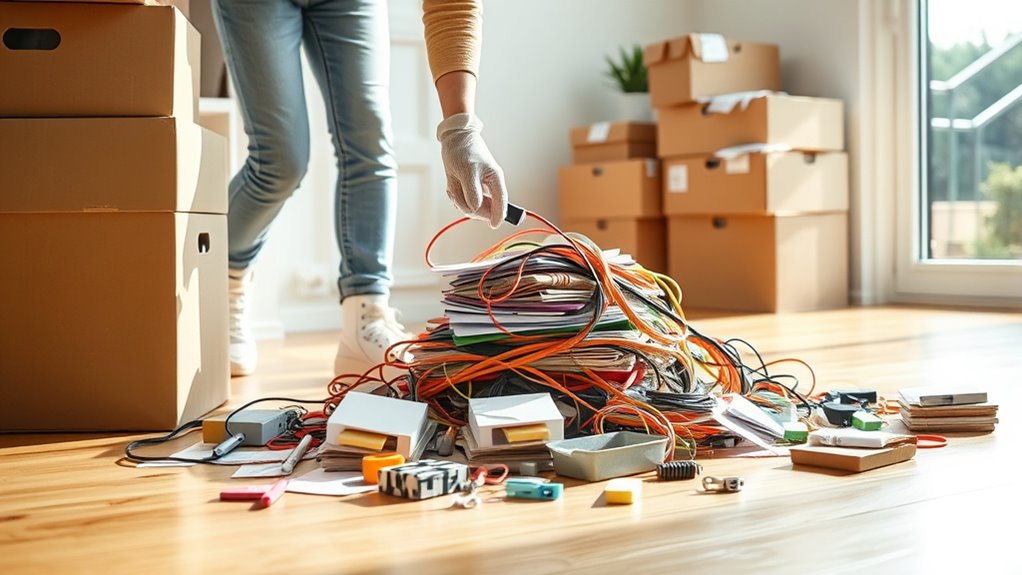To clear clutter in just 100 minutes, focus on quick, targeted decluttering sessions using the 10×10 approach. Set a timer for each 10-minute burst, choose manageable areas, gather your supplies, and work with purpose. Decide what to keep, donate, or discard swiftly, and don’t get stuck on sentimental items. Celebrate small wins along the way. Keep going, and you’ll discover simple strategies to maintain a clutter-free space efficiently—find out how to maximize every minute.
Key Takeaways
- Break the decluttering process into ten focused 10-minute sprints to efficiently clear clutter within 100 minutes.
- Prepare your workspace and gather supplies beforehand to maximize time during each 10-minute session.
- Set specific, manageable goals for each sprint, such as sorting a pile or organizing a shelf.
- Use timers to stay on track and maintain focus, preventing decision fatigue and ensuring steady progress.
- Review achievements after each sprint, celebrate small wins, and adjust strategies to sustain momentum.
Understanding the Power of Short, Focused Decluttering Sessions

Even a few minutes of focused decluttering can make a significant difference. Short, targeted sessions help you improve your time management by preventing overwhelm and keeping tasks manageable. When you concentrate on specific areas for just 10 minutes, your mental focus sharpens, making it easier to decide what to keep or discard. These quick bursts of effort boost your motivation, showing immediate progress without exhausting you. Additionally, incorporating consistent decluttering techniques can help sustain your organizational habits and maintain a clutter-free environment over the long term. Practicing mindful decluttering strategies ensures that your efforts are both effective and emotionally sustainable. Understanding the history of organizational methods can inspire new approaches that align with your personal style, making it easier to stay committed. You’ll find it easier to maintain momentum because you’re not overwhelmed by long sessions. This approach emphasizes quality over quantity, enabling you to stay engaged and effective, ultimately leading to a more streamlined, clutter-free environment.
Setting Up Your 10-Minute Workspace for Success
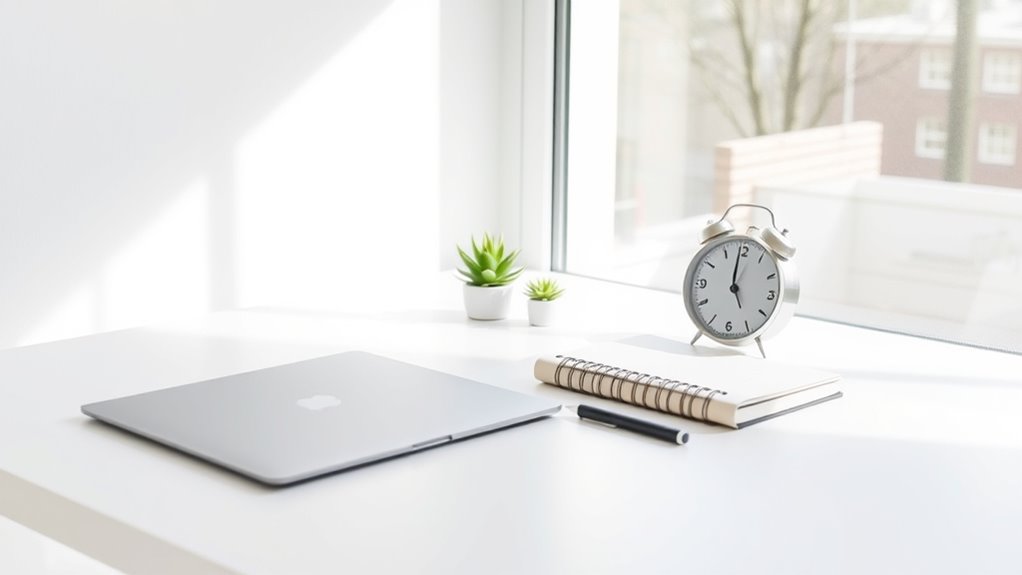
To make the most of your 10-minute declutter session, start by clearing your work zone of any distractions. Gather all the essential supplies you’ll need so you won’t waste time searching for them later. A streamlined space sets the tone for quick, effective progress. Incorporating organization techniques can help maintain your clutter-free zone more efficiently. Remember, establishing clear boundaries and routines can further support your creative practice in staying organized and productive.
Clear Work Zone
Creating a clear work zone is essential for a productive declutter sprint. A tidy space boosts focus and efficiency. Start by organizing your workspace with effective storage solutions to keep clutter out of sight. Guarantee your setup is ergonomic—adjust your chair and desk height for comfort, reducing fatigue. A well-arranged zone minimizes distractions and creates a mental cue to stay on task. Use the following layout to visualize your optimal workspace:
| Storage Solutions | Ergonomic Setup | Focus Enhancements |
|---|---|---|
| Shelves & bins | Adjustable chair | Proper lighting |
| Drawer organizers | Monitor at eye level | Minimal distractions |
| Filing systems | Supportive posture | Clear pathways |
A dedicated, organized space primes you for a swift, successful declutter. Research on workspace arrangement can further optimize your environment for productivity.
Gather Essential Supplies
Gathering the right supplies is the first step to setting up a productive 10-minute workspace. Use effective organizing techniques to gather only what you need, avoiding clutter and distractions. Keep essential tools like pens, notepads, or chargers within easy reach, and set aside items that aren’t immediately necessary. Good supply management ensures you don’t waste time searching for supplies later. As you gather, think about how each item contributes to your decluttering goal, and discard or set aside anything unnecessary. Staying focused on only the essentials helps you maximize your limited time and creates a clean, efficient workspace. Incorporating skincare product knowledge can help you select the best tools and supplies for your decluttering session. Additionally, understanding how to organize with appetizer ideas in mind can inspire creative ways to categorize and store items efficiently. Recognizing the importance of dog names can also add a touch of personality to your space, making it more inviting and personalized. Clear, organized supplies set the tone for a swift, successful declutter session and help you maintain momentum.
Choosing the Right Areas to Tackle First
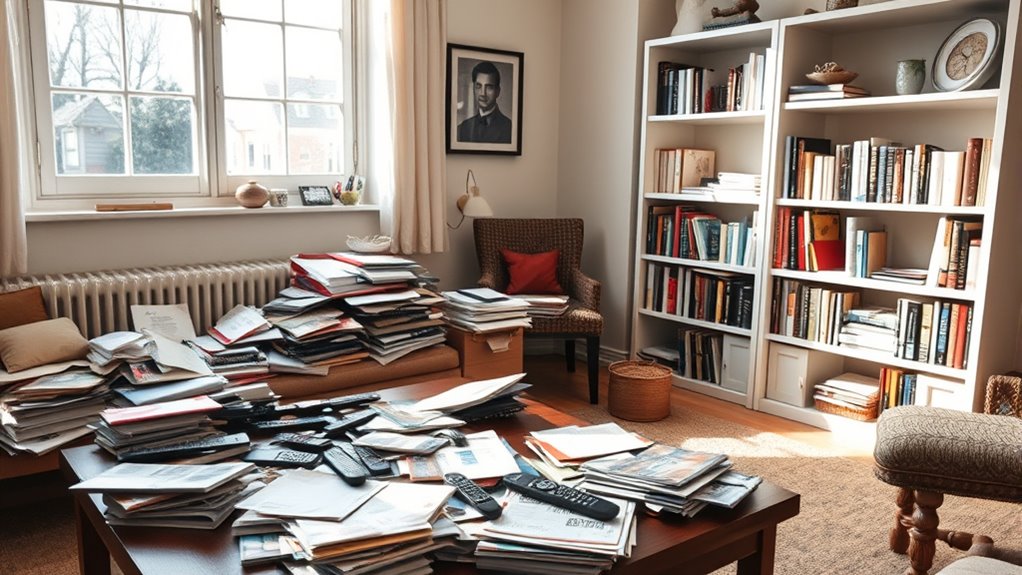
Choosing the right areas to tackle first can make or break your decluttering success. Use prioritization strategies to identify spaces that will give you the biggest impact quickly. Focus on high-traffic zones or clutter hotspots that affect daily routines. Area selection should also consider ease of access; start with spaces that are easier to clear out, so you stay motivated. Avoid spreading yourself thin by trying to declutter multiple areas at once. Instead, pick one or two spots where clutter feels overwhelming yet manageable within your time frame. By choosing the right areas, you set yourself up for momentum, making the entire decluttering process more efficient and rewarding. Remember, strategic area selection is key to completing your 10 × 10 sprint successfully.
Gathering Your Decluttering Tools and Supplies
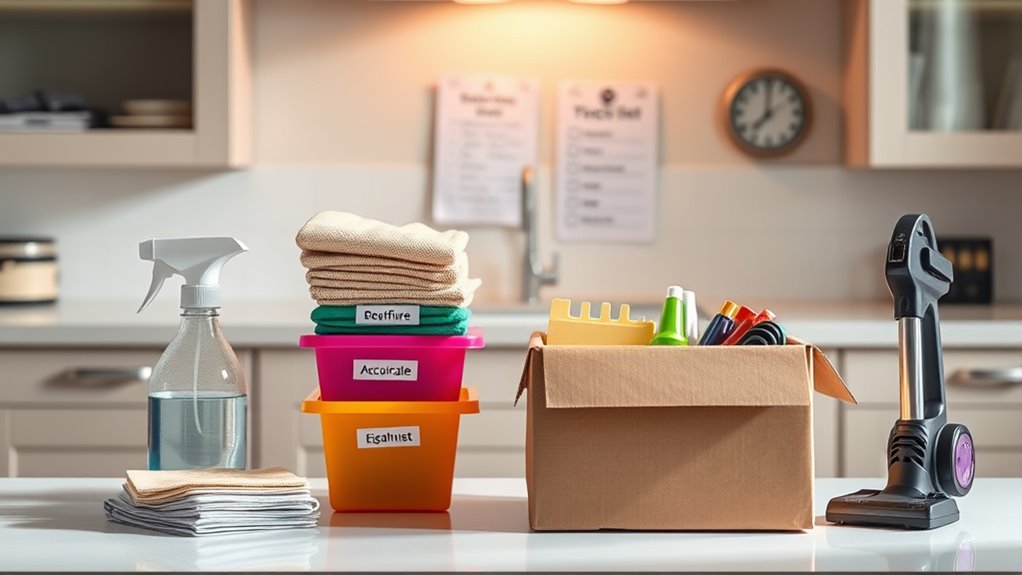
Before you plunge into decluttering, it’s essential to collect the right tools and supplies to make the process smoother and more efficient. Gather basic items like trash bags, recycling bins, and boxes for donations. Having storage solutions ready, such as stackable bins or baskets, will help you organize items as you sort. Make certain your tools are well-organized; use a portable caddy or small container to keep scissors, labels, and markers handy. Clear tool organization minimizes interruptions and keeps you focused. By preparing these supplies beforehand, you streamline your decluttering sprint, making it easier to move quickly through your space. The right tools and storage solutions keep clutter contained and help you stay on track to clear your space efficiently in 100 minutes.
Strategies for Efficient Sorting and Decision-Making
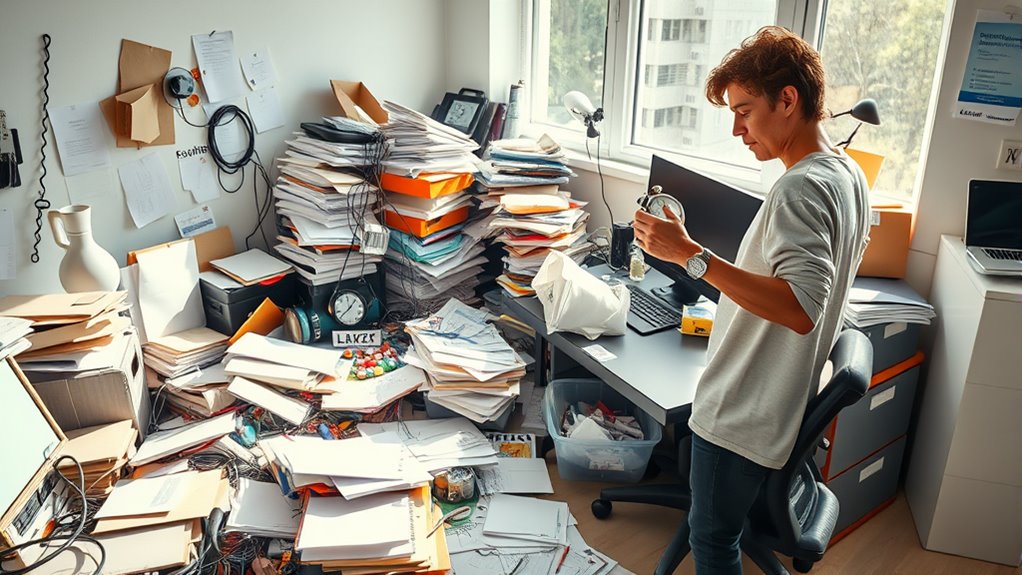
To declutter efficiently, you need a clear strategy for sorting and making quick decisions. Use categorization techniques to group items into meaningful categories—keep, donate, recycle, or discard. This helps streamline your choices and prevents overwhelm. To avoid decision fatigue, set a timer for each sorting session, limiting how long you spend on each pile. Trust your instincts and make swift decisions; don’t second-guess every item. If you’re unsure about something, put it in a temporary “maybe” box to revisit later. Keep your focus on completing one category before moving to the next. These strategies help you stay focused, reduce mental drain, and make the decluttering process faster and more effective.
Staying Motivated During Each 10-Minute Sprint

To stay motivated during each 10-minute sprint, you need clear goals that give you focus and purpose. Reward yourself for completing tasks, which keeps your energy high and your momentum strong. Tracking your progress helps you see how far you’ve come, making it easier to stay committed.
Set Clear Goals
Have you ever noticed how setting specific goals can keep you focused and motivated during quick work sprints? When you clearly define what you want to accomplish, you harness goal visualization to imagine success, which boosts your drive. During each 10-minute sprint, prioritize tasks by setting clear, achievable objectives. This priority setting helps you stay on track and prevents overwhelm. Break your clutter targets into small, manageable goals, like sorting a specific pile or clearing a shelf. Clear goals give you a sense of purpose and momentum, making it easier to plunge in and stay committed. Remember, the more precise your goals, the easier it is to measure progress and stay motivated throughout your decluttering session.
Use Rewards Effectively
Building on your clear goals, rewarding yourself can substantially boost motivation during each 10-minute sprint. Motivational rewards serve as effective incentives, making it easier to stay focused and energized. Choose rewards that genuinely motivate you, like a quick break, a small treat, or listening to your favorite song afterward. These incentives reinforce your progress and create positive associations with decluttering. Keep rewards proportionate to the effort—small, immediate rewards work best for short sprints. By intentionally linking your effort to a reward, you’ll find it easier to stay committed and maintain momentum. Remember, the goal is to make decluttering feel rewarding, not burdensome. Effective incentives turn each mini-session into a motivating step toward a clutter-free space.
Track Progress Regularly
Tracking your progress during each 10-minute sprint keeps you motivated and focused. Regular progress monitoring helps you see how much you’ve accomplished, boosting your confidence to keep going. Use a simple checklist or timer to track what you’ve completed in each interval. Consistency tracking shows you patterns—are certain tasks taking longer? Are you maintaining steady pace? By reviewing your progress after each sprint, you stay aware of your momentum, making adjustments if needed. This ongoing awareness prevents burnout and keeps your decluttering goal within reach. Remember, small wins add up; tracking progress keeps you motivated by highlighting your achievements. Staying consistent with your progress monitoring transforms a formidable task into manageable, energizing steps.
Managing Difficult Items and Sentimental Clutter

Managing difficult items and sentimental clutter can be one of the most emotionally taxing aspects of decluttering, but approaching them with a clear strategy makes the process manageable. Start by identifying items with sentimental value, then ask yourself if they truly serve a purpose or bring joy. Making difficult decisions becomes easier when you set limits—like choosing to keep only a few meaningful items rather than everything. Remember, it’s okay to let go of things that no longer serve you, even if they’re emotionally significant. Focus on honoring your feelings without letting them dictate clutter. Taking a step back to evaluate each item objectively helps you stay focused and avoid overwhelm, ensuring your decluttering sprint stays productive and emotionally manageable.
Incorporating Breaks and Celebrating Small Wins

Incorporating breaks and celebrating small wins are essential strategies to keep your decluttering momentum going. Mindful breaks help you recharge and stay focused, preventing burnout. Celebrate milestones, no matter how small, to boost motivation and recognize progress. Taking short breaks allows you to reset and approach each task with fresh energy. Acknowledge your effort with simple rewards, like a cup of tea or a moment of gratitude. Here’s a quick guide:
| Break Type | Celebration Idea |
|---|---|
| 5-minute stretch | Enjoy a favorite snack |
| Short walk around | Share your achievement with a friend |
| Deep breathing session | Treat yourself to a small treat |
Maintaining Momentum After Completing the Sprint

Once you’ve completed your decluttering sprint, the key is to actively maintain your momentum rather than let it fade away. Building lasting habits helps you stay clutter-free. Here are four ways to keep that momentum going:
- Set small, daily goals to reinforce habit formation.
- Find an accountability partner to stay motivated.
- Schedule regular mini-sprints to prevent clutter buildup.
- Celebrate progress to maintain enthusiasm.
Tips for Sustaining a Clutter-Free Environment Long-Term
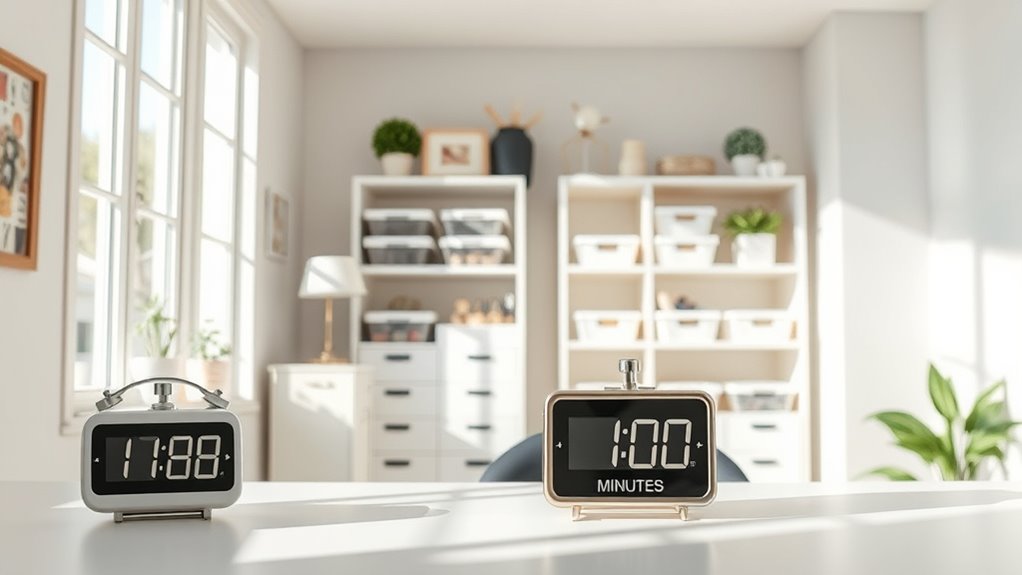
Maintaining a clutter-free environment long-term requires intentional effort and consistent habits. To do this, practice mindful organization by regularly evaluating your space and removing items that no longer serve a purpose. Cultivating a minimalist mindset helps you prioritize quality over quantity, making it easier to resist unnecessary clutter. Develop routines, like daily tidying or weekly reviews, to keep clutter at bay. Use designated storage for essentials and avoid impulse buying. Stay aware of your habits and adjust as needed to maintain clarity and order. Remember, sustaining a clutter-free space is an ongoing process, not a one-time event. By integrating mindful organization and embracing minimalism, you create a supportive environment that stays tidy with less effort over time.
Frequently Asked Questions
How Can I Adapt the 10-Minute Sprints for Larger Cluttered Spaces?
To adapt 10-minute sprints for larger cluttered spaces, start with effective space partitioning, dividing the area into manageable zones. Use task prioritization to decide which zones to tackle first, focusing on the most cluttered or visible sections. Break down each zone into smaller tasks, then allocate time accordingly. This approach keeps you organized, prevents overwhelm, and helps you make steady progress through your entire space.
What if I Feel Overwhelmed During Quick Decluttering Sessions?
If you feel overwhelmed during quick decluttering sessions, it’s normal to experience emotional overwhelm and decision fatigue. Take a deep breath and pause; remind yourself it’s okay to break the process into even smaller steps. Focus on just one small area or a single category. Celebrate each tiny victory, which helps reduce overwhelm and decision fatigue, making the task feel more manageable and less stressful.
Can This Method Be Effective for Shared Living Spaces?
A stitch in time saves nine, so tackling shared living spaces with this method can be effective if everyone participates. You should coordinate with your housemates, dividing tasks based on shared responsibilities. Clear communication strategies help prevent conflicts and keep everyone on the same page. By working together, you can quickly declutter common areas, making your shared space more organized and comfortable for all.
How Do I Handle Sentimental Items During Short Decluttering Bursts?
When handling sentimental items during short decluttering bursts, you focus on emotional attachment without feeling overwhelmed. You can set a timer, quickly assess each item’s significance, and decide whether to keep, donate, or discard. Be honest with yourself about what truly matters, and remember, it’s okay to let go of some items. This approach helps you manage sentimental clutter efficiently, even in brief sessions, without sacrificing emotional well-being.
What Tools Are Most Essential for Maximizing Decluttering Efficiency?
To maximize decluttering efficiency, you need the right tools. Use decluttering apps to organize your tasks and set clear goals, keeping you focused and motivated. Storage containers are essential for sorting and storing items quickly, preventing clutter from spreading. These tools streamline your process, making quick decisions easier and helping you complete your decluttering sprint efficiently. Stay organized, and you’ll see results faster.
Conclusion
Even if a full declutter feels overwhelming, this 10 × 10 sprint proves you can make quick progress without burnout. By focusing on manageable chunks and staying committed, you’ll see immediate results that motivate you to keep going. Remember, perfection isn’t the goal—consistent effort matters. So, embrace these short sessions, and watch your space transform. After all, a clutter-free environment isn’t just about tidiness; it’s about reclaiming your peace of mind.
